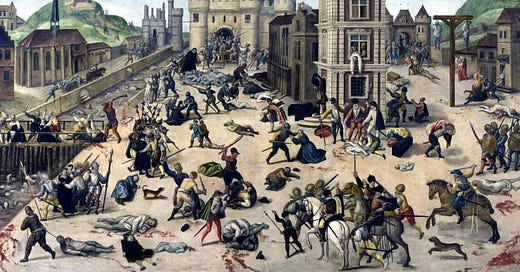The Huguenots in France
Part 1 in a series on Jean Claude, the great Huguenot Preacher and Theologian
Introduction
The life, times, and theology of Jean Claude (1619-1687) are fascinating historical accounts of struggle, conviction, and faithfulness. However, before we can understand why Jean Claude’s life is worth reflecting upon, we must first understand the religious struggles present in France in the late 16th and 17th Centuries. Across continental Europe, the fires of the Reformation were burning. John Calvin and his contemporaries were experiencing conversions and success in Geneva. The protestant faith had spread to the Netherlands and Belgium. The doctrine of justification by grace alone had even crossed the Channel and began to take root in England. In the mid-1500s, Catholic France saw the protestants grow in number, and concerns began forming in the hearts and minds of the French Catholic elite.
The details and nature of the early days of the French Reformed, or Huguenot, church is not the scope of this essay; however, some brief history is necessary to understand the struggles of the Reformed Church in France in the 17th Century. This series will summarize the life and theology of one prominent Huguenot preacher, Jean Claude. First, I will present a brief historical account highlighting two critical moments in French Huguenot history that will help us understand the trials of Jean Claude’s life. Secondly, I will summarize the life and ministry of Jean Claude and focus on some of the specifics of his Reformed theology. Finally, I will reflect on how learning about Jean Claude and Huguenot’s plight has affected me.
The Huguenots in France
The transformation of Calvin’s Geneva spread over the border into France through an illegal book trade, which[1]resulted in the formation of Reformed Churches. Ministers from Geneva were sent to serve these churches; thus, France's reformed church was born. The French Protestants were grounded in French-speaking Geneva, the southern Kingdom of Navarre, and eventually spread throughout France. These “hearty psalm-singing”[2] congregations caused consternation among the Catholic French nobility because it was not just nobles and elites converting to Protestantism but also the lay people. The early struggles of the Huguenots are well documented in the lives of courageous men and women such as Gaspard de Coligny or Marguerite de Navarre during the French Wars of Religion in the 16th Century. The Huguenot church peaked in size in 1562 at 2,150 churches.[3]
St. Bartholomew’s Day
After a sustained period of war and politics, the Huguenot church seemed doomed. After a series of marriages, deaths, and conversions,[4] any peace between the Reformed and Catholics seemed unlikely. In the early hours of August 24, 1572, a three-day massacre of Huguenot leaders and laity commenced on the streets of Paris. This horrible day, still remembered today, resulted in approximately 5000 deaths.[5] The desire for war was rekindled, and the French Wars of Religion continued.
Edict of Nantes
In 1598, a peace treaty was reached. Henry, the King of France, managed to create terms that ended the wars and resulted in the Edict of Nantes, which “granted freedom of conscience and freedom of worship to Huguenots, but not all over France—rather, in cities and towns controlled by Protestants in August 1597, in towns indicated in earlier peace edicts, and in the homes of Protestant nobles.”[6] This peace granted relative stability to the Huguenot church until it was revoked in October of 1685 which resulted in the final expulsion or conversion of the French Reformed Church. In this era, Jean Claude ministered, resisted, and struggled.
Read Part 2:
The ‘Great and Good’ Jean Claude
The esteemed Huguenot minister, Jean Claude,[1] was born in Salvetat, a region in the southwest of France equidistant between Toulouse and Montpellier, in 1619.[2] He was the son of a Protestant minister and fathered a third-generation Protestant minister. Claude studied Philosophy and Divinity at…
[1] “The colporteurs hauled their consignments of books over the Jura Mountains and sold them in France. Some colporteurs lost their lives for their illegal book trade, but the books worked their wonders.” Jeannine Olson, “The Cradle of Reformed Theology: The Reformed Churches from Calvin’s Geneva through Henry IV and the Edict of Nantes,” in The Theology of the French Reformed Churches: From Henri IV to the Revocation of the Edict of Nantes, ed. Martin I. Klauber, Joel R. Beeke, and Jay T. Collier, Reformed Historical-Theological Studies (Grand Rapids, MI: Reformation Heritage Books, 2014), 13.
[2] Ibid, 14.
[3] Ibid, 16.
[4] The latter half of the 16th Century was rife with intrigue and tension between the Reformed and Catholic nobles. The stories of three Huguenot women showcase this well. Rebecca VanDoodewaard, Reformation Women: Sixteenth-Century Figures Who Shaped Christianity’s Rebirth (Grand Rapids, Michigan: Reformation Heritage Books, 2017).
[5] “One can never be exact, but Mack Holt estimates that the dead totalled approximately five thousand.” Jeannine Olson, “The Cradle of Reformed Theology: The Reformed Churches from Calvin’s Geneva through Henry IV and the Edict of Nantes,” in The Theology of the French Reformed Churches: From Henri IV to the Revocation of the Edict of Nantes, ed. Martin I. Klauber, Joel R. Beeke, and Jay T. Collier, Reformed Historical-Theological Studies (Grand Rapids, MI: Reformation Heritage Books, 2014), 17.
[6] Jeannine Olson, “The Cradle of Reformed Theology: The Reformed Churches from Calvin’s Geneva through Henry IV and the Edict of Nantes,” in The Theology of the French Reformed Churches: From Henri IV to the Revocation of the Edict of Nantes, ed. Martin I. Klauber, Joel R. Beeke, and Jay T. Collier, Reformed Historical-Theological Studies (Grand Rapids, MI: Reformation Heritage Books, 2014), 20.





